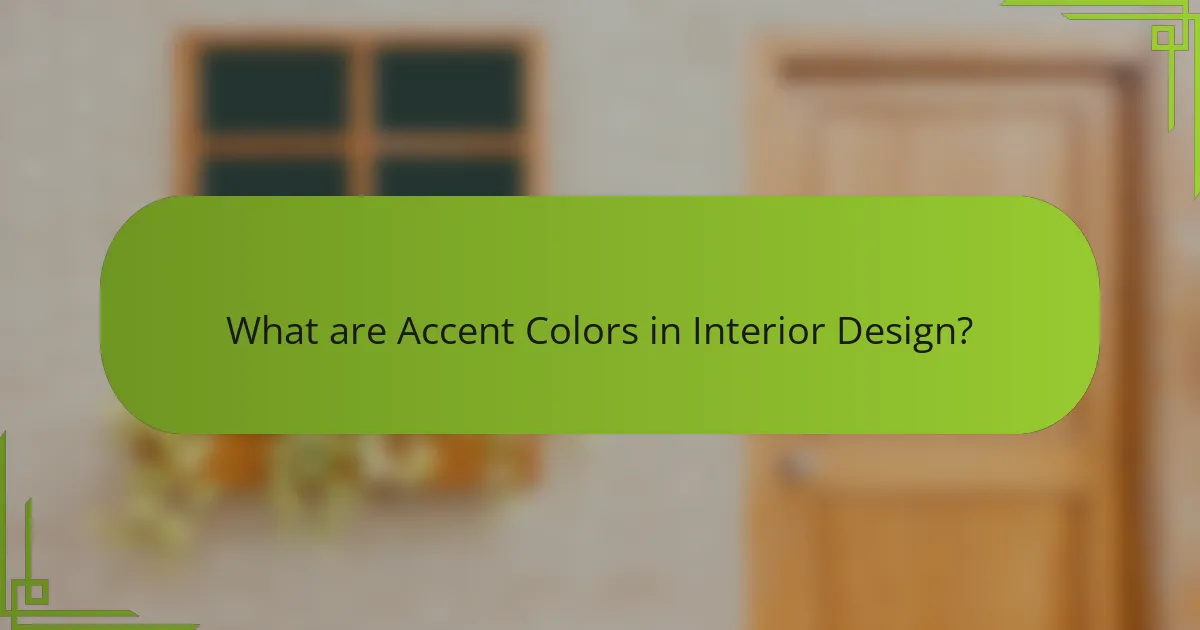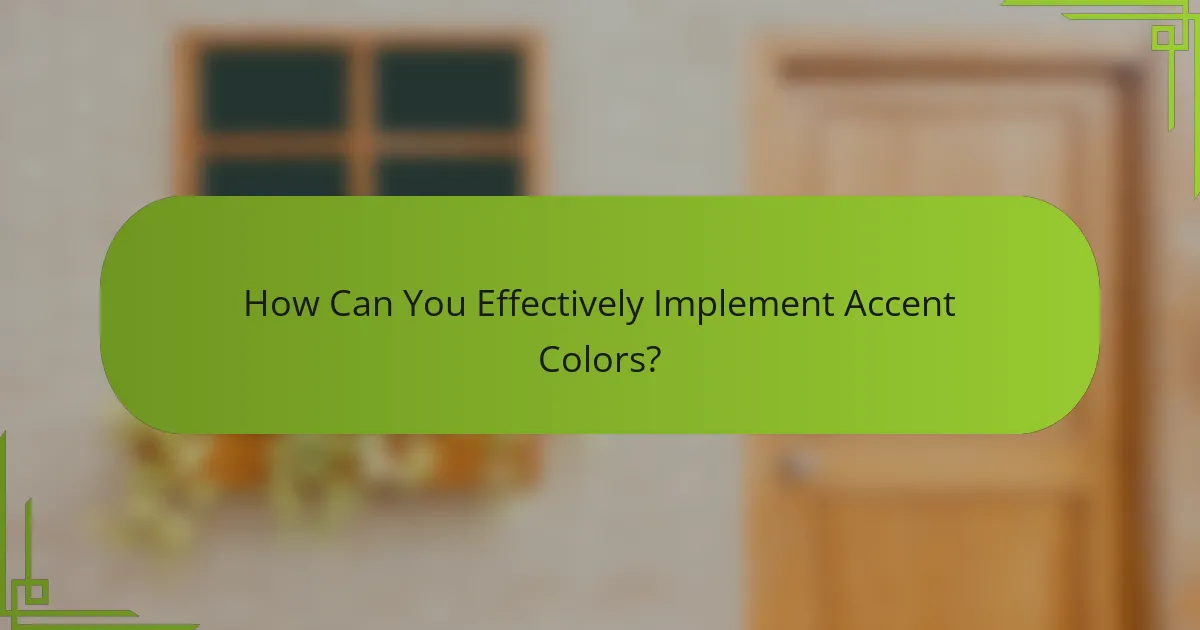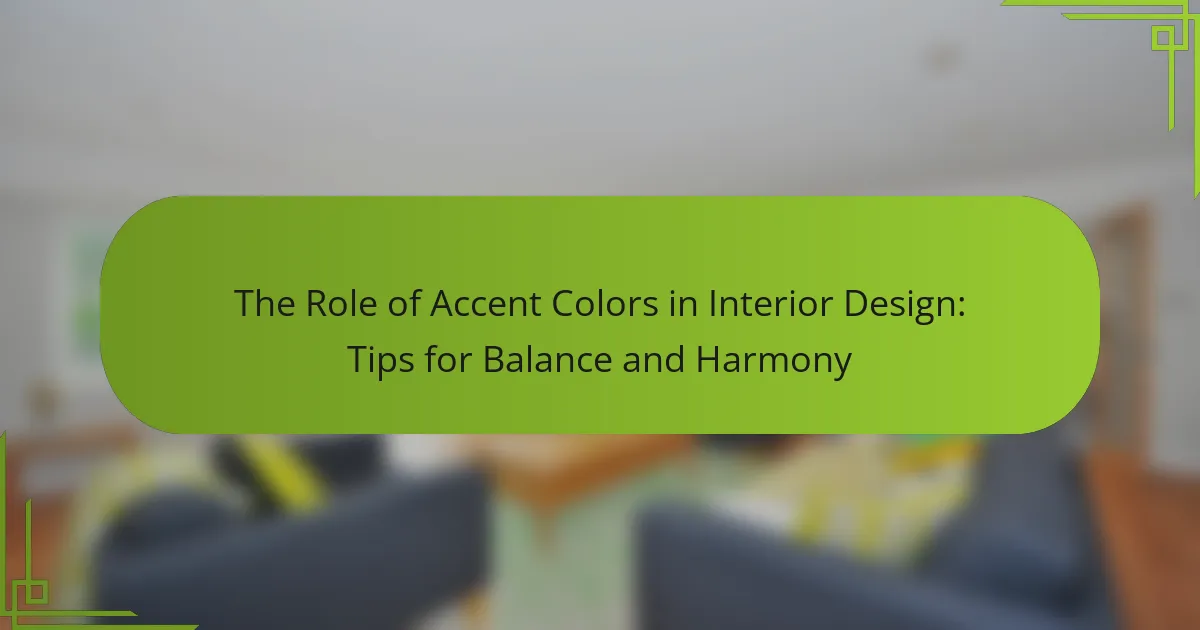
What are Accent Colors in Interior Design?
Accent colors in interior design are hues used to enhance and complement a primary color scheme. They create visual interest and can be used to highlight specific areas or features in a room. Accent colors are often bolder or more vibrant than the dominant colors. This contrast helps to draw attention and add depth to the space. For example, a neutral room may utilize a bright yellow or deep blue as an accent. According to design principles, using accent colors effectively can lead to a more balanced and harmonious environment.
How do accent colors influence the overall design of a space?
Accent colors significantly influence the overall design of a space by creating visual interest and enhancing mood. They draw attention to specific areas or features within a room. For instance, a bold accent color can make a statement wall stand out, providing a focal point. Additionally, accent colors can harmonize or contrast with the primary color scheme. This interplay can evoke different emotions, such as warmth or calmness. Research shows that colors can impact mood; for example, blue tones are often associated with tranquility. Overall, the strategic use of accent colors can transform a space, making it more inviting and aesthetically pleasing.
What are the psychological effects of using accent colors?
Accent colors can significantly influence psychological responses in individuals. They evoke emotions and set the mood in a space. For instance, warm accent colors like red and orange can create feelings of warmth and energy. In contrast, cool accent colors such as blue and green can promote calmness and relaxation.
Research shows that color psychology plays a crucial role in human behavior. A study by the Institute for Color Research found that colors can affect perceptions and reactions. For example, red can increase heart rates, while blue can lower them.
Accent colors can also draw attention to specific areas within a room. This can enhance focus or create a sense of hierarchy in design. Overall, the strategic use of accent colors can lead to improved emotional well-being and a more harmonious living environment.
How do accent colors interact with other design elements?
Accent colors enhance the visual appeal of other design elements. They create contrast and draw attention to focal points. For example, a bright accent color against neutral walls can highlight artwork or furniture. Accent colors can also establish a mood or theme within a space. They interact with textures, patterns, and materials, influencing the overall aesthetic. Research indicates that effective use of accent colors can improve the perceived harmony of a room. Studies show that color combinations impact emotional responses and spatial perception.
Why are accent colors important for balance and harmony?
Accent colors are important for balance and harmony because they create visual interest and contrast. They help to break up monotony in a color scheme. By strategically placing accent colors, designers can guide the viewer’s eye throughout a space. This technique promotes a cohesive and inviting environment. Research indicates that color contrast can influence mood and perception. For example, a study from the University of California found that contrasting colors can enhance emotional responses. Thus, accent colors play a crucial role in achieving aesthetic balance in interior design.
How do accent colors contribute to the mood of a room?
Accent colors significantly influence the mood of a room. They can evoke emotions and set the atmosphere. For example, warm colors like red and orange create energy and excitement. Conversely, cool colors such as blue and green promote calmness and relaxation.
Research indicates that color psychology plays a crucial role in how individuals perceive their environment. A study published in the Journal of Environmental Psychology found that colors can affect mood and behavior. Accent colors can highlight features and create focal points, enhancing the overall aesthetic.
In summary, the choice of accent colors directly impacts the emotional tone of a space.
What role do accent colors play in creating focal points?
Accent colors serve to create focal points in interior design by drawing attention to specific areas or objects. They provide contrast against the dominant color scheme. This contrast enhances visual interest and guides the viewer’s eye. For example, a bright red chair in a neutral room becomes a striking focal point. Research indicates that color contrast can influence perception and focus. A study published in the Journal of Environmental Psychology shows that contrast helps highlight key features in a space. Thus, accent colors are essential for emphasizing elements and enhancing overall design.

What are the Best Practices for Choosing Accent Colors?
Best practices for choosing accent colors include understanding the color wheel and selecting complementary colors. Complementary colors are opposite each other on the color wheel. This creates a vibrant contrast that can enhance the overall design. Additionally, consider the 60-30-10 rule. This rule suggests that 60% of a space should be a dominant color, 30% a secondary color, and 10% an accent color. This balance creates visual harmony.
Another practice is to draw inspiration from existing elements. Use colors found in artwork, furniture, or textiles within the space. This ensures that the accent color feels cohesive. Testing colors in different lighting is also essential. Colors can appear differently based on natural and artificial light. Therefore, viewing them in various settings helps in making the right choice.
Finally, consider the emotional impact of colors. Different colors evoke different feelings. For example, blue can create a calming effect while yellow can energize a space. Understanding these effects can guide the selection of accent colors effectively.
How can you select accent colors that complement your main color scheme?
To select accent colors that complement your main color scheme, start by identifying the primary color. Use the color wheel to find complementary colors, which are opposite each other. Analogous colors, located next to your main color, can also create harmony. Consider the emotional impact of colors; warm colors evoke energy, while cool colors promote calmness. Use a 60-30-10 rule: 60% main color, 30% secondary color, and 10% accent color for balance. Test colors in different lighting to see their true effect. Use samples to visualize how they interact with your main color. These methods help ensure that your accent colors enhance the overall design.
What tools can help in choosing the right accent colors?
Color palette generators can help in choosing the right accent colors. Tools like Adobe Color, Coolors, and Paletton allow users to create and visualize color combinations. These tools provide options for complementary, analogous, and triadic color schemes. Users can input a base color and explore various accent colors. Additionally, they often include features for adjusting saturation and brightness. Many of these tools also offer export options for easy integration into design projects. Research shows that well-chosen accent colors enhance aesthetic appeal and can influence mood.
How do cultural factors influence color choices in design?
Cultural factors significantly influence color choices in design. Different cultures associate specific colors with unique meanings and emotions. For example, in Western cultures, white symbolizes purity and innocence, while in many Eastern cultures, it represents mourning. Colors like red are viewed as symbols of luck in Chinese culture, but can signify danger in Western contexts. These associations impact design decisions, guiding designers to choose colors that resonate with their target audience. Understanding these cultural nuances ensures that designs are not only visually appealing but also culturally relevant. Research shows that color perception is shaped by cultural experiences, highlighting the importance of considering cultural context in design.
What common mistakes should be avoided when using accent colors?
Common mistakes to avoid when using accent colors include overusing them in a space. Too many accent colors can create visual chaos and confusion. It is essential to limit the number of accent colors to maintain harmony. Another mistake is neglecting the existing color palette. Accent colors should complement the primary colors in the room. Ignoring the scale and size of the room is also a mistake. Dark or bold accent colors can overwhelm small spaces. Additionally, failing to consider lighting can alter the perception of accent colors. Natural and artificial light can change how colors appear. Lastly, not testing colors in the actual space is a common error. Colors can look different in various lighting conditions.
How can overusing accent colors disrupt harmony?
Overusing accent colors can disrupt harmony in interior design by creating visual chaos. When too many accent colors are present, they compete for attention. This competition can lead to a disjointed appearance. A balanced color scheme typically includes one or two accent colors. Excessive use can overwhelm the primary color palette. Research indicates that harmonious design relies on color balance for psychological comfort. According to studies, environments with too many contrasting colors can increase stress levels. Therefore, moderation in accent color usage is crucial for maintaining visual harmony.
What are the risks of clashing accent colors?
Clashing accent colors can create visual discord in interior design. This discord may lead to an overwhelming or chaotic atmosphere. It can distract from the overall aesthetic of a space. Clashing colors may also evoke negative emotional responses. Studies show that color combinations affect mood and perception. For instance, contrasting colors can cause eye strain or discomfort. Additionally, poorly chosen accent colors can diminish the impact of key design elements. Overall, careful color selection is essential for harmony in interior spaces.

How Can You Effectively Implement Accent Colors?
To effectively implement accent colors, start by selecting a primary color scheme. This scheme should consist of two to three main colors. Choose accent colors that complement or contrast with these primary colors. Use accent colors sparingly to create focal points in a room. For example, apply them to accessories like cushions, artwork, or vases. This method draws attention without overwhelming the space. Additionally, consider the psychology of colors for emotional impact. Research shows that color combinations can influence mood and perception. Following these guidelines ensures a balanced and harmonious design.
What are the different ways to incorporate accent colors in a room?
Accent colors can be incorporated in a room through various methods. One effective way is by using decorative accessories. Items such as throw pillows, rugs, and artwork can introduce vibrant hues. Painting an accent wall is another popular method. This creates a focal point that draws attention. Additionally, furniture pieces like chairs or ottomans can be upholstered in bold colors.
Another approach involves using window treatments. Curtains in accent colors can enhance the room’s aesthetic. Lighting fixtures also serve as an opportunity for color. Lampshades or pendant lights can add visual interest. Finally, incorporating plants with colorful pots can bring life and vibrancy to the space. Each method allows for a unique expression of style while maintaining balance and harmony in the room.
How does furniture placement affect the perception of accent colors?
Furniture placement significantly influences the perception of accent colors. When furniture is strategically arranged, it can enhance or diminish the visibility of accent colors. For instance, placing a vibrant chair near a neutral wall can make the color pop more prominently. Conversely, overcrowding a space with furniture may overshadow accent colors, making them less noticeable. Additionally, the distance between furniture and accent elements affects how colors are perceived. Closer proximity often leads to heightened visibility. Research shows that color perception is also influenced by surrounding colors and lighting conditions. Therefore, thoughtful furniture placement is crucial for achieving desired visual effects with accent colors.
What role does lighting play in showcasing accent colors?
Lighting significantly enhances the visibility and impact of accent colors in interior design. Proper lighting can highlight the vibrancy of these colors, making them stand out in a space. Natural light can amplify the richness of accent hues, while artificial lighting can create different moods and effects. For instance, warm lighting can soften colors, while cool lighting can make them appear more vivid. The angle and intensity of light also influence how colors are perceived. Studies show that well-lit accent colors can improve the overall aesthetic and emotional appeal of a room. Therefore, strategic lighting is essential for effectively showcasing accent colors.
What tips can enhance the effectiveness of accent colors in your design?
Use a limited color palette to enhance the effectiveness of accent colors in your design. This approach creates visual harmony and prevents overwhelming the viewer. Choose one or two accent colors that complement the primary color scheme. Implement these accents in strategic locations to draw attention to key areas. Balance is crucial; ensure that accent colors do not dominate the space. Consider the emotional impact of colors; for example, blue can evoke calmness while red can energize a room. Test the colors in various lighting conditions to see how they interact. Finally, incorporate textures and patterns to add depth and interest alongside accent colors.
How can you create a cohesive look with accent colors?
To create a cohesive look with accent colors, choose a limited color palette. Select one or two accent colors that complement your primary color scheme. Use these accent colors consistently across various elements in the space. Incorporate them in accessories, artwork, and furniture. Balance is key; ensure that the accent colors are not overwhelming. For example, using a bold accent color on smaller items can create visual interest without dominating the overall design. Studies show that a cohesive color scheme enhances the aesthetic appeal of a space.
What are some examples of successful accent color combinations?
Successful accent color combinations include navy blue and gold, teal and coral, and gray and mustard yellow. Navy blue paired with gold creates a sophisticated and elegant look. Teal and coral provide a vibrant and refreshing contrast. Gray and mustard yellow offer a modern and stylish appeal. These combinations enhance visual interest and harmony in interior design.
The main entity of this article is accent colors in interior design, which are hues used to enhance and complement primary color schemes, creating visual interest and depth in a space. The article outlines the influence of accent colors on overall design, mood, and psychological effects, emphasizing their role in achieving balance and harmony. It discusses best practices for selecting accent colors, tools for color choice, cultural influences, common mistakes to avoid, and methods for effective implementation. Additionally, it highlights the significance of furniture placement and lighting in showcasing accent colors, along with tips for creating a cohesive look and successful accent color combinations.
